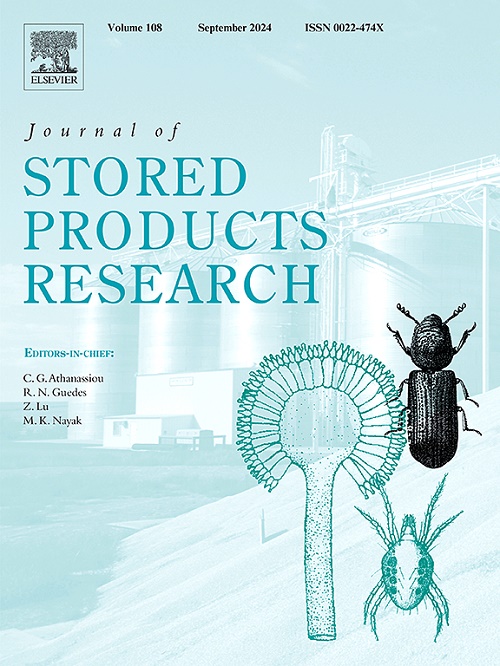植物油与磷化氢对储粮主要害虫的联合防治作用
IF 2.7
2区 农林科学
Q1 ENTOMOLOGY
引用次数: 0
摘要
植物精油具有多种杀虫作用,易于生物降解,对哺乳动物的毒性低,是农药的替代来源。然而,大多数植物性杀虫剂对降解很敏感,因此在虫害防治实践中需要经常大量重复使用。植物性杀虫剂与现有杀虫剂混合使用是解决这些问题的可行途径。因此,以花椒果实为原料制备植物油。和柑橘(棕)。通过加氢蒸馏。本试验研究了自制黄姜油、黄姜油、商品大蒜油、磷化氢及其二元混合剂对小蠹蛾(鞘翅目:Bostrichidae)、玉米象蛾(curculionae)、玉米蛾蛾(Herbst)(鞘翅目:拟甲科)、铁蛾蛾(Cryptolestes ferrugineus)(鞘翅目:拟甲科)、嗜虫蛾(Enderlein) (Psocodea: liposcelidae)成虫的熏蒸毒性。虽然玉米螟和铁螟成虫对磷化氢的敏感性高于其他3种植物油,但大蒜油和黄樟油对多米家蝇、castaneum家蝇和嗜虫螟成虫的熏蒸毒性与磷化氢相当。白蜡油与磷化氢配伍对5种储粮害虫成虫均无增效作用。以255∶1和1:1的质量比混合,对蓖麻螟和嗜虫螟成虫的增效作用最大。当大蒜油与膦分别以13∶1和728∶1的质量比混合时,对玉米螟和小蠹成虫的增效作用最大。鉴于植物性杀虫剂熏蒸毒性协同作用和施用剂量低的优点,植物油与磷化氢二元混合熏蒸是一种很有前途的储藏产品害虫防治和磷化氢抗性管理策略。本文章由计算机程序翻译,如有差异,请以英文原文为准。
Joint action of plant oils and phosphine against major stored product pests
Plant essential oils are an alternative source to pesticides due to their multiple modes of insecticidal action, easy biodegradability, and low mammalian toxicity. However, most botanical insecticides are sensitive to degradation, thus requiring frequent reapplication of large amounts of them in pest control practices. Mixing botanical insecticides with currently available insecticides is a feasible way to solve these issues. Therefore, plant oils were prepared from fruits of Zanthoxylum bungeanum Maxim. and Citrus maxima (Burm.) Osbeck (Sapindales: Rutaceae) through hydrodistillation. Fumigation toxicity of self-made Z. bungeanum oil and C. maxima oil, commercial garlic oil, phosphine and their binary mixtures against adults of Rhyzopertha dominica (Fabricius) (Coleoptera: Bostrichidae), Sitophilus zeamais Motschulsky (Coleoptera: Curculionidae), Tribolium castaneum (Herbst) (Coleoptera: Tenebrionidae), Cryptolestes ferrugineus (Stephens) (Coleoptera: Laemophloeidae), and Liposcelis entomophila (Enderlein) (Psocodea: Liposcelididae) was investigated in this study. Although adults of S. zeamais and C. ferrugineus were more sensitive to phosphine than to three plant oils, fumigation toxicity of garlic oil or Z. bungeanum oil against adults of R. dominica, T. castaneum, and L. entomophila was comparable to that of phosphine. The combination of Z. bungeanum oil and phosphine did not show any synergism against adults of five stored product pests. When C. maxima oil and phosphine were mixed at the mass ratios of 255: 1 and 1: 1, respectively, they showed the greatest synergistic toxicity against adults of T. castaneum and L. entomophila. When garlic oil and phosphine were mixed at the mass ratios of 13: 1 and 728: 1, respectively, they showed the greatest synergistic toxicity against adults of R. dominica and S. zeamais. In terms of the advantages of synergism in fumigation toxicity and low application dosages of botanical insecticides, fumigation with binary mixtures of plant oils and phosphine is a promising strategy for stored product pest control and management of phosphine resistance.
求助全文
通过发布文献求助,成功后即可免费获取论文全文。
去求助
来源期刊
CiteScore
5.70
自引率
18.50%
发文量
112
审稿时长
45 days
期刊介绍:
The Journal of Stored Products Research provides an international medium for the publication of both reviews and original results from laboratory and field studies on the preservation and safety of stored products, notably food stocks, covering storage-related problems from the producer through the supply chain to the consumer. Stored products are characterised by having relatively low moisture content and include raw and semi-processed foods, animal feedstuffs, and a range of other durable items, including materials such as clothing or museum artefacts.

 求助内容:
求助内容: 应助结果提醒方式:
应助结果提醒方式:


